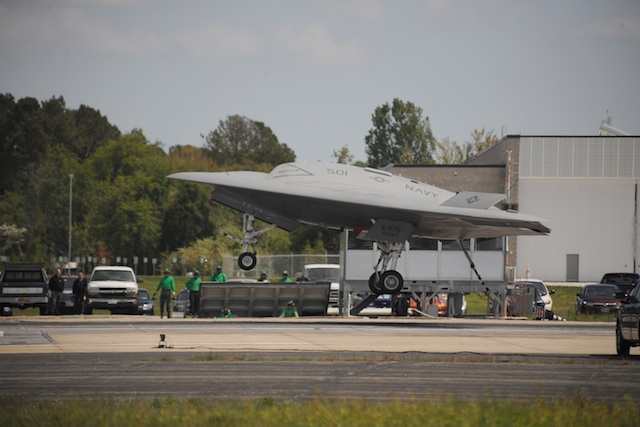
Cue the Kenny Loggins soundtrack, we have a high profile Naval aircraft landing. The Navy's X-47B Unmanned Combat Air System (UCAS) demonstrator drone—AKA the "Iron Raven"—proved it could at least land on something the size of an aircraft carrier deck, making its first "tailhook" arrested landing on May 4 at Patuxent River Naval Air Station in Maryland. This success sets the stage for the X-48B to go to sea for flight testing aboard the aircraft carrier USS George H. W. Bush later this month.
Unlike most current drones, the X-47B has no remote pilot. It's flown entirely by onboard artificial intelligence software. Built by Northrop Grumman initially as part of Defense Advanced Research Projects Agency's Joint UCAS (J-UCAS) research program, the X-47B is maneuvered into place on the ground with a wireless remote. So once it's been catapulted to takeoff, it's all hands-off. Its course and mission can be controlled remotely via mouseclicks, but it takes off, lands, and does what it needs to do in between without human help.
In February, Rear Admiral Matthias Winter said the X-47B "will never carry a weapon" when talking to attendees of an unmanned aircraft conference about a question posed by Wired's Spencer Ackerman. It does, however, have the capability to carry a payload of 4,000 pounds, so it could conceivably play roles in combat surveillance and electronic warfare. A follow-on drone, the X-47C, is planned to have the capacity to carry 10,000 pounds of armaments—all of which will be standard Navy weaponry certified for other aircraft.
The Navy has been testing and flying drones since the late 1980s, when it began testing the Israeli-designed Pioneer RPV aboard the battleship USS Iowa (BB-61) as a forward spotter for naval gunfire (tests that were personally witnessed by this author). The Pioneer saw combat duty during the Gulf War, most famously when Iraqi troops on Fallaka Island surrendered to a Pioneer flown off the USS Wisconsin (BB-64).
But the Navy's drones have never been operated off the deck of an aircraft carrier. Until recently, they haven't even been armed (though the Navy has developed weapons for smaller drones and it has looked at using small drones as guided bombs).
The tailhook landing of the X-47B comes on the heels of another Navy drone milestone—the activation of the Navy's first squadron of both manned and unmanned aircraft. Helicopter Maritime Strike Squadron 35 (HSL-35), a squadron deactivated in 1992, has been reformed with eight manned helicopters and 10 Fire Scout MQ-8 B helicopter drones. Eventually, HSL-35 squadron commander Cmdr. Christopher Hewlett told Navy Times, the MQ-8s will be armed.
reader comments
67